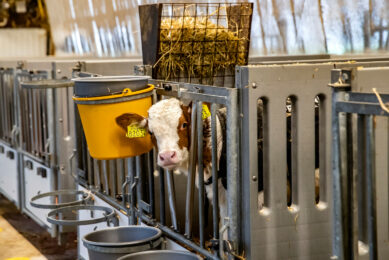Calf diarrhoea control starts with the dry cow

In order to reduce the costs of rearing, it is important to let the calves grow fast, especially in the first 6 months.
At 6 months of age, the calves should weigh between 210 and 230 kilos, and that is often not achieved at farms, mostly due to diarrhoea problems. As a result, € 50 to € 140 per lactation is lost in the productive life of the dairy cows (click here for file), according to nutritionist Yves Senlis from the French premix supplier MiXscience. Mr Senlis presented this view at the Eurotier, which is taking place this week in Hanover, Germany. We spoke with Mr Senlis about why the ideal weight of the calves is not reached.
Fast growth in the first 6 months is a guarantee for having a successful lactating cow. But what goes wrong?
“Mistakes are made in the management. Every dairy farmer knows how to do it, but does not do it everywhere as it should. That is why you have to take a close look at all the factors involved in calf rearing. Our consultants have a standard checklist for this (see checklist), so that they can score the management on separate elements and give them a score (good, can be improved or poor). By doing this, it is easier to see and define the weak points, so the farmer can improve on specific elements.”
Which order of approach is important in this?
“So firstly we focus on the analysis and plan, as mentioned before. Then we take a look at biosecurity. This entails the sale and purchase movement of calves, but also little things such as hand washing before and after treating animals, farm clothing for visitors, foot baths and the eradication of unwanted insects and animals such as rats. Only after that we will discuss the animal feed. Do the animals get enough energy, protein and minerals, what is the feed quality and impact on food safety and which additives are used? Lastly, we look at parasites, coccidiosis and cryptosporidium. If you use a different order to look at all of these things, it is useless. First the basis must be right.”

But the infection route of the calves is very important right and used in practice?
“That’s right, but that does’t work. If there are really sick animals you have to call in the veterinarian, not a feed advisor. A feed advisor mainly has to think and work from a prevention point of view. This could be for example the use of targeted premixes (Protonat2C) that we sell. But doing this can only be effective if the things I mentioned earlier are reasonably in order. Only then can you increase the resistance of the animals around the weaning period and reduce diarrhoea problems, caused by crypto and coccidiosis. In trials we carried out, we saw a 75% reduction in oocytes at the age of weaning and a 58% reduction in the period thereafter. The severity of the diarrhoea also decreased considerably: by 0.9 points on a scale of 0 to 5. ”
What does it cost and how to use the premixes in practice?
“It costs about € 4 to € 5 per ton of compound feed and according to trials, the yields are 4 times higher. It is important that you feed it to the young stock and the dry cows. The latter is an important group because dry cows can excrete a lot of contaminants around calving when they weaken. This means the risk increases that the calf gets infected. I would not recommend feeding it to the other group of lactating cows, as it is less effective and less economical interesting.”
Join 13,000+ subscribers
Subscribe to our newsletter to stay updated about all the need-to-know content in the dairy sector, two times a week.










